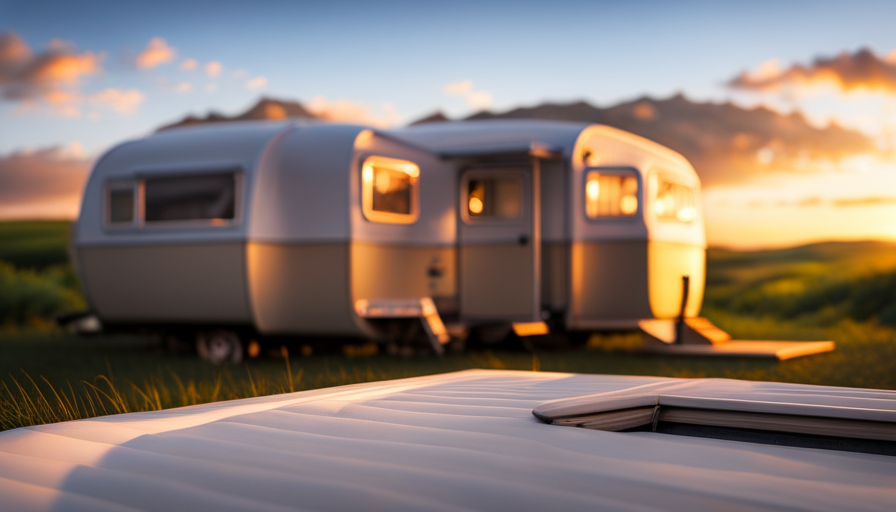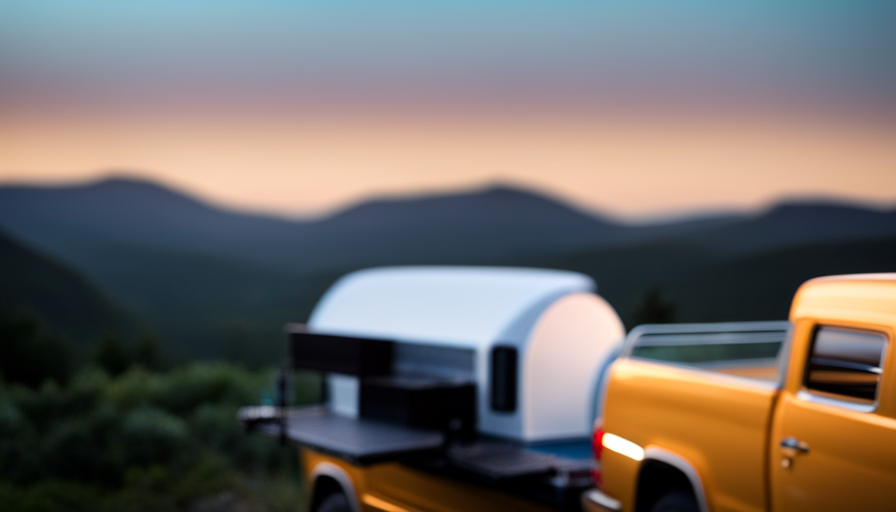“Home is where the heart is” is a well-known saying. However, what happens when you are exploring new places far away and enjoying the freedom that comes with traveling? During those times, your trusty camper becomes essential, providing a cozy place for you to unwind and recharge.
However, if you’ve ever spent a night tossing and turning on an uncomfortable camper bed, you know that a good night’s sleep is crucial to fully enjoying your adventures. That’s why I’m here to share some tips on how to make your camper bed more comfortable.
From investing in a high-quality mattress topper to creating a cozy ambiance with soft lighting and decor, these simple yet effective strategies will help you optimize your sleeping experience on the road.
So, let’s dive in and transform your camper bed into a haven of comfort and relaxation.
Key Takeaways
- Assess the current state of the camper bed and consider replacing it if necessary
- Invest in a high-quality mattress topper made of memory foam or gel-infused foam
- Add extra cushions and pillows for support, including camping pillows, body pillows, and memory foam seat cushions
- Adjust the temperature for optimal comfort, including regulating ventilation and using a cooling mattress pad
Assess the Current State of Your Camper Bed
Take a moment to assess how your camper bed feels and looks, so you can determine the areas that need improvement. Evaluating the mattress quality is crucial as it directly impacts your comfort level. Consider the firmness and support it provides. If it feels lumpy or saggy, it might be time for a replacement.
Additionally, inspect the condition of the mattress itself. Are there any tears or stains? Utilize space efficiently by checking if your bedframe has storage compartments or drawers underneath. This allows you to maximize the limited space in your camper. Consider investing in a high-quality mattress topper to enhance your sleeping experience. A mattress topper can provide extra cushioning and support, transforming an uncomfortable bed into a cozy haven.
Look for one that’s made of memory foam or gel-infused foam, as these materials conform to your body shape and relieve pressure points. With a well-chosen mattress topper, you can significantly improve the comfort of your camper bed.
Invest in a High-Quality Mattress Topper
Consider investing in a top-notch mattress topper to enhance your camping slumber. When it comes to choosing the right mattress topper for your camper bed, you have two popular options: memory foam and latex foam. Each has its own pros and cons to consider.
Memory foam mattress toppers are known for their excellent contouring ability, providing personalized support and relieving pressure points. On the other hand, latex foam mattress toppers offer a more responsive and bouncy feel, with natural hypoallergenic properties.
When selecting the thickness and density of your mattress topper, there are a few tips to keep in mind. For a camper bed, a thickness of 2 to 3 inches is usually sufficient to add comfort without compromising space. As for density, a higher density will provide more support, but may feel firmer. It’s important to find the right balance between comfort and support that suits your individual preferences.
Now, let’s transition into the next section about adding extra cushions and pillows for support.
Add Extra Cushions and Pillows for Support
Enhance your camping slumber by adding extra cushions and pillows to provide optimal support for a restful night’s sleep. Here are four ways to incorporate extra padding and create a cozy sleeping environment:
-
Invest in a supportive camping pillow: A good camping pillow can make a world of difference in providing neck and head support. Look for one that offers adjustable firmness and is specifically designed for outdoor use.
-
Use body pillows for added comfort: Body pillows can provide extra support for your back, hips, and knees, especially if you’re sleeping on an uneven surface. They can help align your spine and reduce pressure points.
-
Try a memory foam seat cushion: If you’re sleeping in a camper with limited space or alternative sleeping arrangements, a memory foam seat cushion can provide additional comfort and support. It can be placed under your sleeping bag or mattress to add a layer of cushioning.
-
Stack up the throw pillows: Don’t be afraid to bring a few extra throw pillows from home. They can be used to prop up your head or legs, or simply to add a touch of comfort and coziness to your sleeping area.
By incorporating these extra cushions and pillows, you can create a more comfortable sleeping arrangement for your camping adventures. This will ensure a better night’s sleep and leave you feeling refreshed in the morning.
Now, let’s explore how to adjust the temperature for optimal comfort.
Adjust the Temperature for Optimal Comfort
Regulate the temperature to create a cozy sleeping haven that keeps you cool on warm summer nights and warm on chilly evenings. Adjusting the ventilation in your camper can make a significant difference in your comfort level. Proper airflow helps to regulate the temperature and prevents the air from becoming stagnant or stuffy. Open windows and vents to allow fresh air to circulate throughout the space. Additionally, consider using a cooling mattress pad. These pads are designed to absorb and dissipate body heat, keeping you cool throughout the night. They are typically made with materials such as gel-infused memory foam or breathable fabrics that promote air circulation.
To help you visualize the benefits of adjusting the ventilation and using a cooling mattress pad, refer to the table below:
| Benefits of Adjusting Ventilation and Using a Cooling Mattress Pad |
|---|
| Regulates temperature |
| Prevents stuffiness |
| Enhances airflow |
| Promotes better sleep |
Creating a comfortable camper bed involves not only regulating the temperature but also creating a cozy ambiance with soft lighting and decor. Transitioning into the next section, let’s explore how these elements can contribute to a more relaxing and inviting sleeping space.
Create a Cozy Ambiance with Soft Lighting and Decor
To transform your sleeping space into a relaxing oasis, imagine the cozy ambiance created by soft lighting and carefully chosen decor. Soft lighting not only adds a warm and inviting atmosphere but also helps relax your mind and body for a restful sleep. Here are some soft lighting ideas and cozy decor inspiration to make your camper bed more comfortable:
-
String lights: Hang delicate fairy lights around the bed area to create a magical and cozy atmosphere.
-
Bedside lamps: Choose lamps with soft, warm-toned bulbs to provide a gentle glow for reading or winding down.
-
Candle lanterns: Opt for flameless candles in lanterns to add a cozy and romantic touch without the worry of fire hazards.
-
Dimmer switches: Install dimmer switches to control the brightness of the overhead lights, allowing you to adjust the ambiance to your preference.
-
Himalayan salt lamp: Place a Himalayan salt lamp on your bedside table to create a soothing and calming effect with its soft, pink glow.
By incorporating these soft lighting ideas and cozy decor inspiration, you can create a tranquil retreat in your camper bed.
Next, let’s explore how to make your sleeping space even more comfortable by using bedding with breathable and moisture-wicking materials.
Use Bedding with Breathable and Moisture-Wicking Materials
After creating a cozy ambiance with soft lighting and decor, the next step in making your camper bed more comfortable is to choose bedding with breathable and moisture-wicking materials. When it comes to bedding, comfort is key, especially when you’re sleeping in a confined space like a camper.
Breathable bedding options, such as cotton or bamboo sheets, allow air to circulate and prevent overheating during the night. These materials also have moisture-wicking properties, which means they absorb and evaporate sweat, keeping you cool and dry throughout the night.
Investing in a mattress topper made from breathable and moisture-wicking materials can also make a significant difference in your comfort levels. Memory foam or gel-infused mattress toppers can provide additional support and cushioning, ensuring a restful night’s sleep. Additionally, consider using pillows with similar properties to keep your head and neck properly aligned and comfortable.
By selecting bedding with breathable and moisture-wicking materials, you can create a more comfortable sleeping environment in your camper. In the next section, we will explore how to optimize your sleep position for better rest, ensuring that you wake up feeling refreshed and rejuvenated.
Optimize Your Sleep Position for Better Rest
Snuggle up in your camper bed and drift off to dreamland by finding the perfect sleep position for ultimate relaxation. When it comes to sleeping in a camper, it’s important to consider the limited space and the need for comfort. Here are some tips to optimize your sleep position and make your camper bed more comfortable:
-
Sleeping positions:
- Back sleeping: Sleeping on your back is often recommended for proper spinal alignment. Use a pillow to support your neck and a cushion under your knees to relieve pressure on your lower back.
- Side sleeping: If you prefer sleeping on your side, use a supportive pillow that keeps your head and neck aligned with your spine. Place a pillow between your knees to reduce strain on your hips.
-
Choosing the right bedding:
- Mattress topper: Invest in a high-quality mattress topper that provides extra cushioning and support for your camper bed.
- Breathable sheets: Opt for bedding made from breathable and moisture-wicking materials like cotton or bamboo. This will help regulate your body temperature and prevent night sweats.
By incorporating these sleeping positions and choosing the right bedding, you can transform your camper bed into a cozy haven for a restful night’s sleep. Now, let’s explore how incorporating relaxation techniques before bedtime can further enhance your sleep experience.
Incorporate Relaxation Techniques before Bedtime
Unwind and prepare for a restful night by incorporating relaxation techniques into your bedtime routine. Relaxation techniques can help calm your mind and body, promoting a deeper and more comfortable sleep.
One effective technique is deep breathing. Taking slow, deep breaths can help slow down your heart rate and relax your muscles, making it easier to fall asleep.
Another technique is progressive muscle relaxation. This involves tightening and then releasing each muscle group in your body, starting from your toes and working your way up to your head. By doing so, you can release tension from your muscles and promote relaxation.
Additionally, practicing mindfulness or meditation before bed can help quiet your mind and alleviate any racing thoughts that may be keeping you awake.
By incorporating these relaxation techniques into your bedtime routine, you can create a more peaceful and comfortable environment for sleep.
Transitioning into the next section, keeping your sleeping area clean and clutter-free is also important for optimizing your sleep quality.
Keep Your Sleeping Area Clean and Clutter-Free
To optimize your sleep quality, it’s crucial to maintain a tidy and organized sleeping area free from clutter. A clean and clutter-free camper bed can greatly enhance your comfort and relaxation.
Here are some cleaning hacks and organization tips to help you achieve just that:
-
Declutter: Start by removing any unnecessary items from your sleeping area. Keep only the essentials to create a serene and peaceful atmosphere.
-
Regularly clean your bedding: Wash your sheets, pillowcases, and blankets regularly to keep them fresh and free from dirt or allergens. This will contribute to a more hygienic sleeping environment.
-
Vacuum and dust: Take the time to vacuum and dust your camper bed regularly. This will help eliminate any dust mites or allergens that may have accumulated over time.
-
Use storage solutions: Utilize storage containers or bins to keep your belongings organized and out of sight. This will not only create a neater sleeping area but also make it easier to find what you need.
By implementing these cleaning hacks and organization tips, you can transform your camper bed into a clean and clutter-free oasis of relaxation. Taking care of your sleeping area is essential for ensuring longevity and comfort.
Take Care of Your Camper Bed to Ensure Longevity and Comfort
As I mentioned earlier, keeping your sleeping area clean and clutter-free is essential for a comfortable camper bed. However, it’s not just about cleanliness; you also need to take care of your camper bed to ensure its longevity and enhance comfort.
One crucial aspect to consider is improving ventilation in your camper bed. Proper airflow can make a significant difference in your sleeping experience. Ensure that your mattress and bedding materials allow for adequate air circulation, preventing moisture buildup and potential discomfort. Additionally, consider investing in a mattress topper with cooling properties to regulate temperature and provide a more comfortable sleep surface.
Another key factor in enhancing comfort is choosing the right bedding. Opt for high-quality sheets that are soft and breathable. Cotton or bamboo-based fabrics are excellent choices as they offer superior comfort and moisture-wicking properties. Additionally, consider investing in a supportive pillow that aligns with your sleeping preferences.
By following these tips to improve ventilation and select the right bedding, you can significantly enhance the comfort of your camper bed. Remember, a well-maintained and comfortable sleeping area will not only provide you with a good night’s sleep but also ensure the longevity of your camper bed for many adventures to come.
Frequently Asked Questions
Should I completely replace my camper bed if it’s uncomfortable?
If your camper bed is uncomfortable, you don’t necessarily have to completely replace it. There are comfortable alternatives that can improve your sleeping experience without breaking the bank.
Consider investing in a mattress topper or a memory foam pad to add extra cushioning and support. Another option is to use a high-quality sleeping bag or a self-inflating camping mat. These options can significantly enhance the comfort of your camper bed without the need for a complete replacement.
How can I make my camper bed feel more like a traditional bed?
To make a camper bed feel more like a traditional bed, I’d recommend considering camper bed alternatives that provide more comfort and support. One option is to add a memory foam mattress topper, which can make the sleeping surface feel plush and cozy. Another idea is to invest in high-quality bedding, like soft sheets and fluffy pillows, to enhance overall comfort. Creating a cozy sleeping environment with warm lighting and calming scents can also contribute to a more traditional bed-like experience.
Are there specific mattress toppers that are better for camper beds?
There are indeed specific mattress topper options that can greatly enhance the comfort of camper beds. One popular choice is memory foam mattress toppers, which contour to your body and provide excellent support.
Another option is latex mattress toppers, known for their durability and breathability. Both types offer the benefit of added cushioning and can help alleviate pressure points, resulting in a more comfortable and restful sleep experience in your camper bed.
What are some relaxation techniques I can incorporate before bedtime to improve my sleep in a camper bed?
To improve sleep in a camper bed, incorporating relaxation techniques before bedtime can be beneficial. Some techniques that I recommend include deep breathing exercises, progressive muscle relaxation, and guided meditation.
Deep breathing helps to calm the mind and relax the body, while progressive muscle relaxation involves tensing and releasing different muscle groups to promote relaxation. Guided meditation can also be helpful in quieting the mind and preparing for a restful sleep.
These relaxation techniques can greatly enhance sleep quality in a camper bed.
How often should I clean my camper bed to maintain its comfort and longevity?
Cleaning your camper bed regularly is essential to maintain its comfort and longevity. The frequency of cleaning depends on various factors such as usage and personal preference, but I recommend cleaning it at least once every few months to ensure optimal comfort.
A clean bed not only improves hygiene but also eliminates dust and allergens that can impact your comfort. Regular cleaning will help extend the lifespan of your camper bed, ensuring you can enjoy a comfortable sleep for years to come.
Conclusion
In conclusion, making your camper bed more comfortable is essential for a good night’s sleep while on the road. By assessing the current state of your bed and investing in a high-quality mattress topper, you can significantly improve its comfort level.
Adding extra cushions and pillows, adjusting the temperature, and creating a cozy ambiance with soft lighting and decor are additional ways to enhance your sleeping experience.
Incorporating relaxation techniques before bedtime and keeping your sleeping area clean and clutter-free also contribute to a more comfortable rest. Interestingly, studies have shown that a comfortable sleeping environment can improve sleep quality by up to 80%, leading to improved overall well-being and performance during the day.
So, take care of your camper bed, and enjoy the benefits of a comfortable and restful sleep while enjoying your camping adventures.










